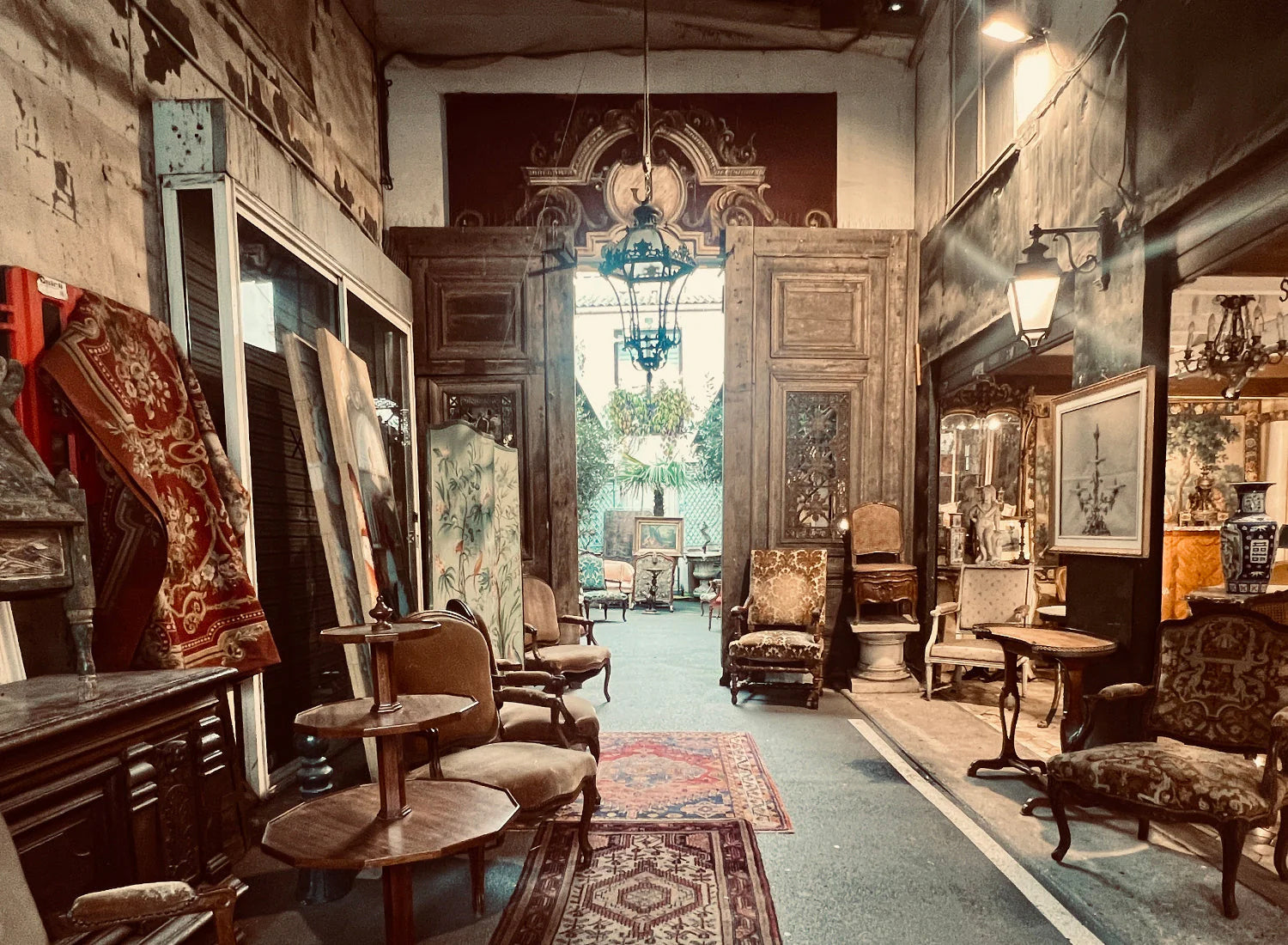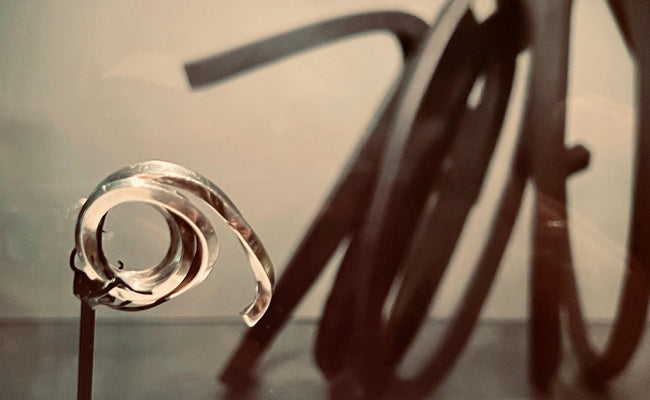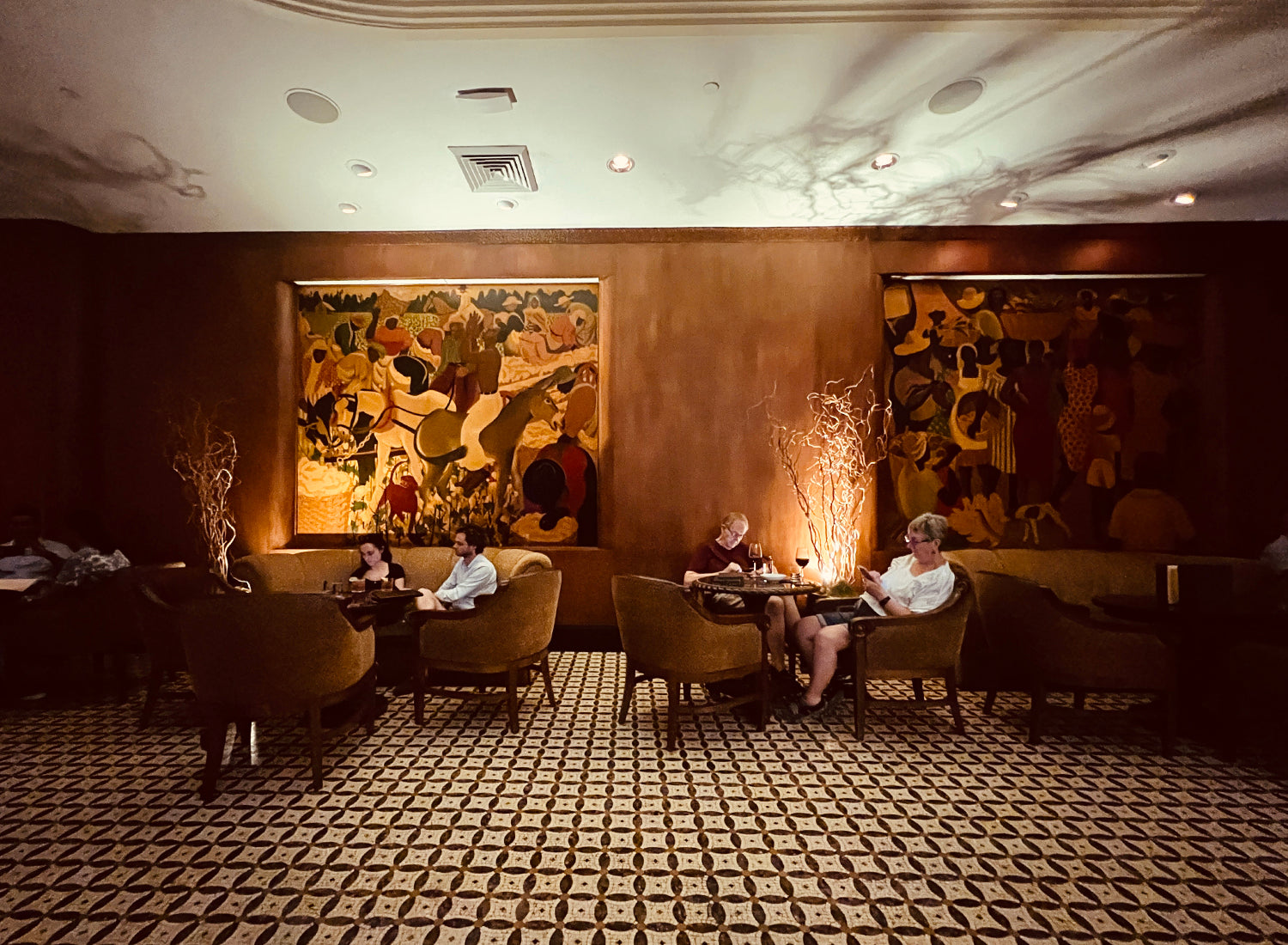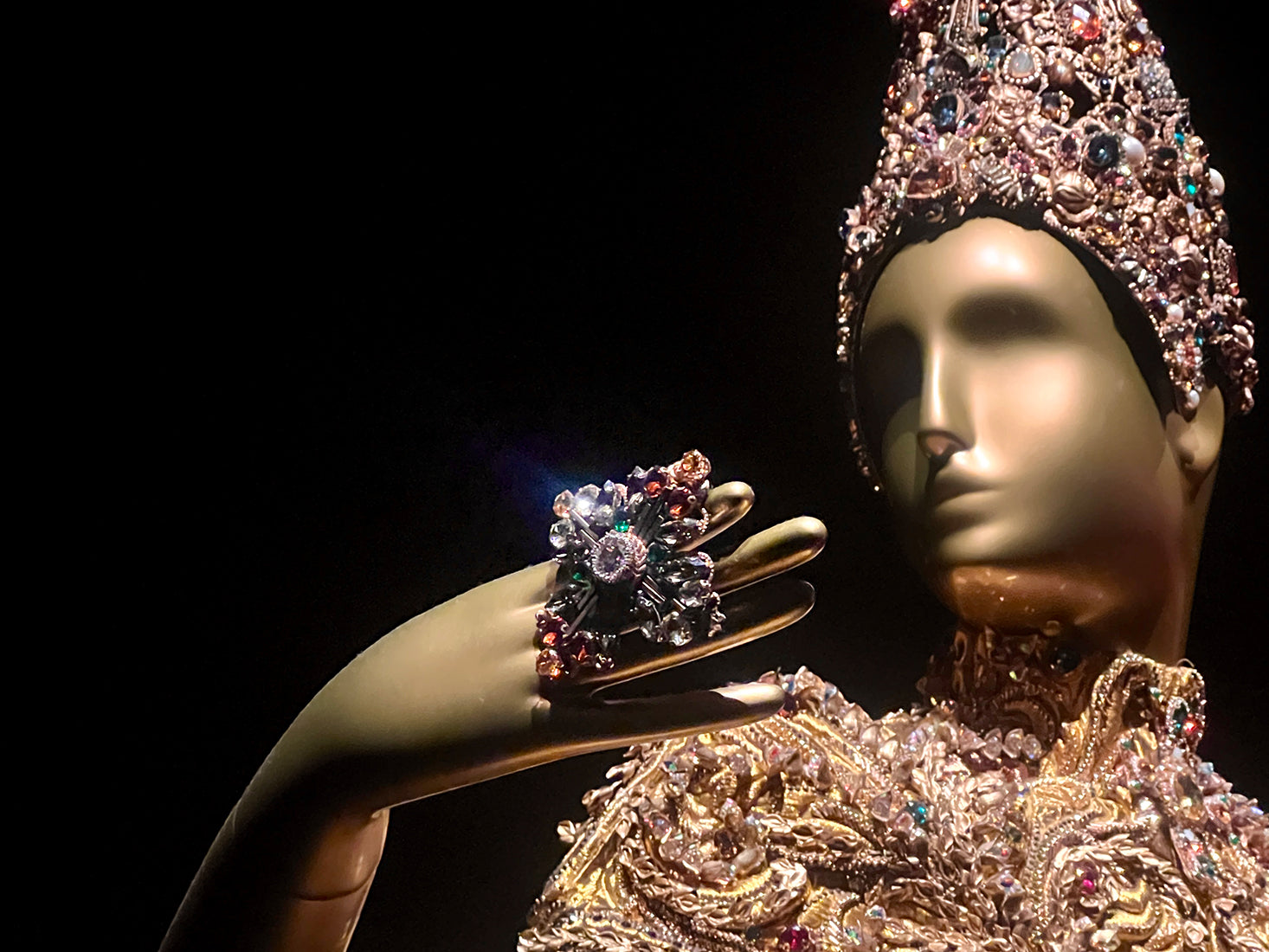
A Jewelry Collector’s Guide to the Best Vintage Market in Paris
There’s vintage shopping in Paris, and then there’s Marché aux Puces de Saint-Ouen.
Tucked just beyond the 18th arrondissement at the edge of the city, Saint-Ouen isn’t your average flea market. It's a sprawling maze of antique stalls, specialty dealers, and tiny jewel-box shops selling everything from 19th-century chandelier prisms to Deco-era cigarette cases and stackable gold bangles with the kind of patina only time can give.
I went on a Monday. The buzz had died down, and the market felt less like a performance and more like a conversation. The crowds were thinner, the shopkeepers less distracted, and the serious collectors were out. These are the ones who know the difference between brass and gold, or a paste stone and an old-mine diamond.
That’s when the fun began.


THE ALLEYS AND SHOPS OF THE SAN OUEN MARKET IN PARIS. PHOTOS: ©ALLOYALIST
Where Eras Collide
Saint-Ouen isn’t one market, it’s several. Spread across more than a dozen distinct sections, each has its own personality.
- Marché Vernaison is the heart of it all. A winding network of tiny stalls, many operated by the same vendors for decades. You’ll find everything here, from vintage brass picture frames and Bakelite brooches to delicate Art Nouveau lockets and obscure mid-century modernist pieces that are far more wearable than they look at first glance.
- Marché Paul Bert and Serpette is where things get more curated, and yes, a bit pricier. You’ll spot Georgian lover's eye jewelry tucked into velvet-lined cases, French Art Deco bracelets, and sometimes a rare Cartier-signed piece quietly offered behind the counter. This section is a must for anyone looking for exceptional vintage jewelry and decorative objects with provenance.
- Marché Dauphine is a mix. Rows of secondhand books, vintage posters, costume jewelry from the '60s and '70s, and the occasional dealer with something truly special if you know where to look. I spent more time here than expected.


THE SAN OUEN FEATURES MANY NARROW PASSAGES THAT OPEN UP TO GARDENS FILLED WITH ANTIQUES. PHOTOS: ©ALLOYALIST
Jewelry & Object Highlights
I’ve spent almost two decades reimagining vintage jewelry. If you count my amateur-thrifting days at Patricia Field in the 90s, even longer. I’ve developed an eye not just for beauty, but for potential—for what can be worn again, reworked, or simply appreciated as-is. Here's what I stopped for:
- Twelve Roman-inspired coins that deserve a proper introduction. For now, I’ll just say they’re unforgettable.
- A suite of 1920s Egyptian Revival pieces, likely produced during the post-Tutankhamun excavation craze. The enamel detail was still intact.
- Several 19th-century sterling and low-karat gold English medals—not religious, but civic or academic. Perfect to convert into bold pendants or charms.
- A forgotten velvet tray filled with hand-cut Bohemian garnets, some in intact brooches, others loose and just waiting for their next setting.
- A rare set of six French sterling tumblers with intricate banded borders. Elegant, understated, and absolutely usable. Yes, I believe in using these things, carefully of course.
- A beautifully crafted French sterling teacup and saucer, with dramatic repoussé leaf detailing. A true objet d’art, signed and weighty.
- Two sterling spoons with bamboo-inspired handles and sculptural finials. One was a fan, the other inscribed with what appears to be Japanese kanji.
- A sleek French sterling egg cup and saucer set, with clean lines, subtle engraving, and a graceful silhouette. The spoon was long gone, but I eventually paired it with a perfectly scaled English one. Slight mismatch? Maybe. But they’re getting along beautifully.


MANY SHOPS REMAIN SHUTTERED ON MONDAYS, BUT OTHER SHOPS SPILL OUT INTO THE ALLEYS. PHOTOS: ©ALLOYALIST
One piece that I absolutely adored but left behind was a massive repoussé-like wall sculpture (or originally, a tray?) featuring a reclining woman, likely cast in pewter or a mixed metal alloy. The detailing was extraordinary: rippling textures, expressive movement, and a tactile energy that felt like late Art Nouveau or early Art Deco. The maker’s mark read Susse Frères, Paris with a signature Ledru, likely referring to sculptor Léon-Ernest Drivier Ledru, who worked with the foundry in the early 20th century. It probably weighed a few thousand kilos (give or take, ha), and though I didn’t have the means to ship it back, I would have built my entire apartment around it if Paris was home. In all seriousness, I could have decorated my whole abode from this market alone. (The piece is below for those who have read this far!)

LEDRU'S GORGEOUS WORK FOR SUSSE FRERES IN PARIS. PHOTOS: ©ALLOYALIST
Buyer Beware (and Be Smart)
Let’s be real. Markets like this are part wonderland, part Wild West. You’ll find treasure, yes...but also plenty of trapdoors.
If you’re new to vintage shopping, and/or new to San Ouen, here are a few tips:
- Know your materials. There’s a lot of brass posing as gold, and “vintage” that’s really just last year’s fast fashion with a dusty filter. Look for hallmarks, test the weight, bring your loupe, and don’t be afraid to ask questions.
- Go early… or go Monday. The weekends are bustling, but Mondays feel more local—and more focused. Fewer browsers, more buyers. The die-hard vendors are the ones who open up shop, and that often means better haggling (it's an art), and more time to look without being rushed. The dealers always seem ready with a story and a cigarette, happy to linger in conversation as long as you are.
- Don’t be afraid to negotiate. It's part of the dance. That said, be respectful! Many dealers are experts and have good reason for their prices.
- Cash is king, but stay alert. Many dealers will offer a better price if you pay in cash, but be smart about it. The area surrounding the market has a reputation for pickpocketing and opportunists. A reputable (key word!) dealer will often walk you to an ATM or currency exchange office themselves (another reason I prefer Mondays, as this kind of help just doesn’t happen when the crowds are in full force). Trust your instincts, keep your bag secure, and don’t hesitate to ask a local vendor for assistance if something feels off.
- Be cautious with QR codes. A few dealers asked me to scan codes stickered on pieces for more information. This is a new practice I haven't seen before. I recommend letting them do the scanning. QR codes can extract more data from your phone than you'd expect (location, IP address, browsing behavior and who knows what else) so it's safer to have the dealer scan and explain it to you, rather than the other way around.
- Trust your gut... with the piece, and with the dealer. If something feels off, it probably is. If a piece speaks to you but feels too good to be true (like a $10 Victorian mourning ring or a $2000 ivory bangle) there’s usually a reason. Just know what you’re paying for, and who you’re buying it from.


LEFT: A SAMPLE OF SAN OUEN WARES. RIGHT: A DEALER SCANNING HIS OWN QR CODE AFTER I REFUSED TO DO IT. PHOTOS: ©ALLOYALIST
Why San Ouen is a Must
If you love craftsmanship, history, and shiny things with soul, this market is for you. But if you're someone who appreciates pieces with a past and the art of giving them a future, it’s more than a recommendation... It’s a MUST. This isn’t about fast fashion or mass production. It’s about finding the piece that feels like it was waiting for you... The locket no one else noticed... The brooch that becomes your signature... The forgotten treasure that needed a little polish and the right person to bring it back to life.
Want to See What I Found?
I brought back a few of my favorite beauties—vintage, storied, and hand-selected from my time at Saint-Ouen. They’ll be released soon, right here. Join my mailing list below and you’ll be the first to know when these treasures drop! I promise to only send you stuff when its absolutely worth it.

 PATH TO THE SAN OUEN MARKET. PHOTOS: ©ALLOYALIST
PATH TO THE SAN OUEN MARKET. PHOTOS: ©ALLOYALIST
When To Go and How to Get There
The Marché aux Puces de Saint-Ouen in Paris is officially open Saturday through Monday, but each day has its own rhythm:
-
Saturday is lively and full of promise. Most dealers are open, and you’ll have time to wander without Sunday’s crowds.
-
Sunday has the buzz... crowds, chaos, and the occasional Chanel spotting. Great for people-watching. Less great if you’re prone to chasing ten things at once and leaving with none.
-
Monday is a collector’s dream. This is by far my favorite day, but keep in mind not every dealer is open.
-
Friday is unofficial. Some vendors set up and open in the afternoon. It’s hit or miss, but sometimes that’s when the magic happens.
Take Metro Line 4 to Porte de Clignancourt, then follow the crowd and walk under the périphérique (Paris’s ring road) into the neighborhood of Saint-Ouen and just past the overpass.
Unpopular (and probably non-local) opinion alert: Before spending hours at the market, I grab my espresso to go at the Mob House Café (70 Rue des Rosiers)—not because it’s the best coffee (it’s not), but because I love Philippe Starck and am a sucker for interiors with polished concrete. But if you want the real fix—there is a street vendor in front of the old Picolo (around 11 Rue Jules Vallès). It’s scrappy, no-frills, and the espresso hits harder than a dealer haggling on a Monday. You're welcome.






2 comments
Such a fun blog post-fantasy of mine — to be able to frequent Saint Ouen more frequently!!!
Jessica Sternthal
Fantastic!!! Congratulations!!!
Maria Grazia Facciola
Leave a comment
This site is protected by hCaptcha and the hCaptcha Privacy Policy and Terms of Service apply.